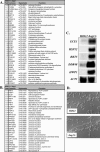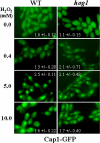Role of the Hog1 stress-activated protein kinase in the global transcriptional response to stress in the fungal pathogen Candida albicans
- PMID: 16339080
- PMCID: PMC1356608
- DOI: 10.1091/mbc.e05-06-0501
Role of the Hog1 stress-activated protein kinase in the global transcriptional response to stress in the fungal pathogen Candida albicans
Abstract
The resistance of Candida albicans to many stresses is dependent on the stress-activated protein kinase (SAPK) Hog1. Hence we have explored the role of Hog1 in the regulation of transcriptional responses to stress. DNA microarrays were used to characterize the global transcriptional responses of HOG1 and hog1 cells to three stress conditions that activate the Hog1 SAPK: osmotic stress, oxidative stress, and heavy metal stress. This revealed both stress-specific transcriptional responses and a core transcriptional response to stress in C. albicans. The core transcriptional response was characterized by a subset of genes that responded in a stereotypical manner to all of the stresses analyzed. Inactivation of HOG1 significantly attenuated transcriptional responses to osmotic and heavy metal stresses, but not to oxidative stress, and this was reflected in the role of Hog1 in the regulation of C. albicans core stress genes. Instead, the Cap1 transcription factor plays a key role in the oxidative stress regulation of C. albicans core stress genes. Our data show that the SAPK network in C. albicans has diverged from corresponding networks in model yeasts and that the C. albicans SAPK pathway functions in parallel with other pathways to regulate the core transcriptional response to stress.
Figures











Similar articles
-
A conserved stress-activated protein kinase regulates a core stress response in the human pathogen Candida albicans.Mol Biol Cell. 2004 Sep;15(9):4179-90. doi: 10.1091/mbc.e04-03-0181. Epub 2004 Jun 30. Mol Biol Cell. 2004. PMID: 15229284 Free PMC article.
-
Histatin 5 initiates osmotic stress response in Candida albicans via activation of the Hog1 mitogen-activated protein kinase pathway.Eukaryot Cell. 2007 Oct;6(10):1876-88. doi: 10.1128/EC.00039-07. Epub 2007 Aug 22. Eukaryot Cell. 2007. PMID: 17715369 Free PMC article.
-
The Hog1 mitogen-activated protein kinase is essential in the oxidative stress response and chlamydospore formation in Candida albicans.Eukaryot Cell. 2003 Apr;2(2):351-61. doi: 10.1128/EC.2.2.351-361.2003. Eukaryot Cell. 2003. PMID: 12684384 Free PMC article.
-
Stress-Activated Protein Kinases in Human Fungal Pathogens.Front Cell Infect Microbiol. 2019 Jul 17;9:261. doi: 10.3389/fcimb.2019.00261. eCollection 2019. Front Cell Infect Microbiol. 2019. PMID: 31380304 Free PMC article. Review.
-
The role of MAPK signal transduction pathways in the response to oxidative stress in the fungal pathogen Candida albicans: implications in virulence.Curr Protein Pept Sci. 2010 Dec;11(8):693-703. doi: 10.2174/138920310794557655. Curr Protein Pept Sci. 2010. PMID: 21235505 Review.
Cited by
-
Candida albicans Cek1 mitogen-activated protein kinase signaling enhances fungicidal activity of salivary histatin 5.Antimicrob Agents Chemother. 2015;59(6):3460-8. doi: 10.1128/AAC.00214-15. Epub 2015 Mar 30. Antimicrob Agents Chemother. 2015. PMID: 25824232 Free PMC article.
-
Genome-wide transcriptional profiling and enrichment mapping reveal divergent and conserved roles of Sko1 in the Candida albicans osmotic stress response.Genomics. 2013 Oct;102(4):363-71. doi: 10.1016/j.ygeno.2013.06.002. Epub 2013 Jun 15. Genomics. 2013. PMID: 23773966 Free PMC article.
-
Identification and mechanism of action of the plant defensin NaD1 as a new member of the antifungal drug arsenal against Candida albicans.Antimicrob Agents Chemother. 2013 Aug;57(8):3667-75. doi: 10.1128/AAC.00365-13. Epub 2013 May 20. Antimicrob Agents Chemother. 2013. PMID: 23689717 Free PMC article.
-
Probiotic interference of Lactobacillus rhamnosus GR-1 and Lactobacillus reuteri RC-14 with the opportunistic fungal pathogen Candida albicans.Infect Dis Obstet Gynecol. 2012;2012:636474. doi: 10.1155/2012/636474. Epub 2012 Jul 1. Infect Dis Obstet Gynecol. 2012. PMID: 22811591 Free PMC article.
-
Differential Gene Expression of Heat Shock Protein 90 (Hsp90) of Candida albicans obtained from Malaysian and Iranian Patients.Malays J Med Sci. 2016 May;23(3):64-71. Malays J Med Sci. 2016. PMID: 27418871 Free PMC article.
References
-
- Altschul, S. F., Gish, W., Miller, W., Myers, E. W., and Lipman, D. J. (1990). Basic local alignment search tool. J. Mol. Biol. 215, 403-410. - PubMed
Publication types
MeSH terms
Substances
Grants and funding
LinkOut - more resources
Full Text Sources
Molecular Biology Databases
Research Materials
Miscellaneous

